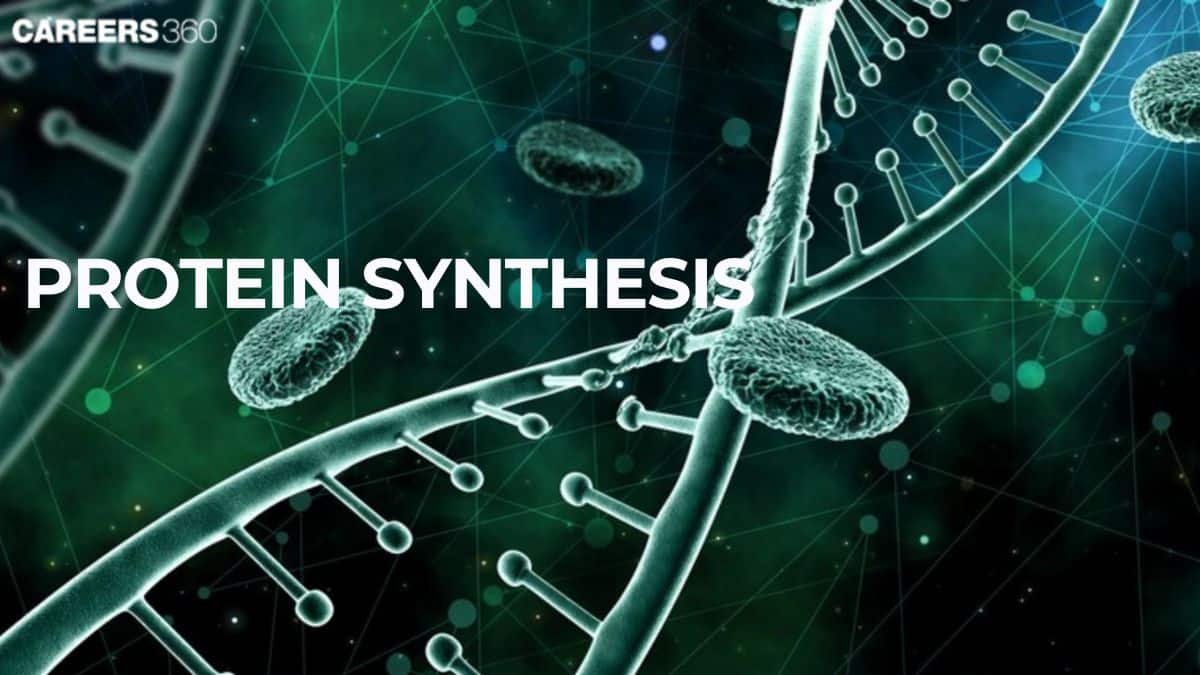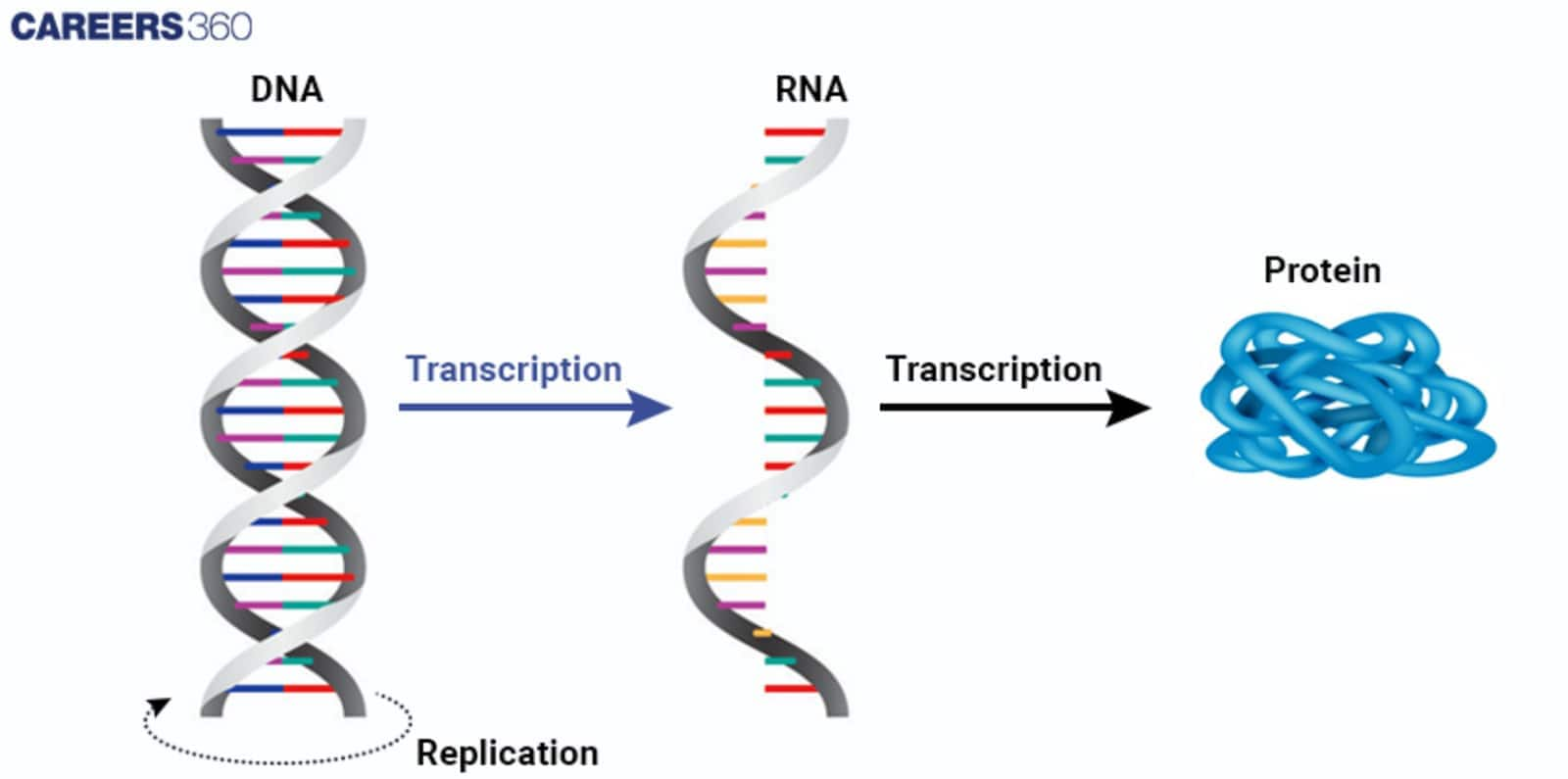Protein Synthesis: Definition, Steps and Examples
Protein synthesis is an important biological process that occurs inside the cells, producing new protein molecules. Proteins perform a number of functions, including functioning as enzymes, structural proteins, or hormones. It is a very similar process for both prokaryotes and eukaryotic cells, but they have certain distinct features.
- What is Protein Synthesis?
- Key Processes Involved in Protein Synthesis
- Molecular Players
- Ribosomes
- Factors Affecting Protein Synthesis
- Recommended video for "Protein Synthesis"
- MCQs on Protein Synthesis

The process can be divided into two phases—transcription and translation. During transcription, a part of DNA encoding the protein, known as a gene, is converted into mRNA. This process is carried out by enzymes, known as RNA polymerase, in the nucleus of the cell. Then, in translation, the mRNA is read by ribosomes to determine the sequence of amino acids forming the polypeptide. Protein synthesis is an important topic of the chapter Molecular Basis of Inheritance. It is an important chapter in the Biology subject.
What is Protein Synthesis?
The central dogma of molecular biology details the flow of information in a biological system. It stated that the information flowed from DNA to RNA and then to proteins. Proteins are important molecules that perform different functions, mainly structure, catalysis of biochemical reactions, and regulation in cells.
This is carried out through the basic biological process of transcription, or the copying of a part of the DNA strand into mRNA. The mRNA then becomes a template for translation by its reading by ribosomes, with the synthesis of a polypeptide chain that folds to assume a given functional protein. This flow of information from DNA to RNA to protein underlies the expression of genetic traits in all living organisms.
Understanding protein synthesis is central to how genes direct cellular functions and the accurate transmission and expression of genetic material. Mistakes in each of these processes could result in a myriad of genetic disorders and diseases, further underlining the concept of the central dogma of molecular biology in maintaining cellular integrity and function.
Diagram: Central Dogma of Molecular Biology

Key Processes Involved in Protein Synthesis
The two important subprocesses in protein synthesis, transcription and the process of translation, work interdependently to carry out the process of conversion of genetic information into functional proteins.
Transcription
Transcription is a process of copying genetic material from DNA into mRNA. Such an mRNA has the role of carrying the genetic code from the nucleus into the ribosome to become a template for protein synthesis.
Steps Involved
Initiation: An RNA polymerase binds to the promoter region of a gene, unwinds the DNA, and initiates the synthesis of RNA.
Elongation: The RNA polymerase moves along the DNA template, adding RNA nucleotides that are complementary in sequence to the DNA strand.
Termination: When RNA polymerase encounters a termination signal, it releases the newly produced mRNA and disengages from the DNA.
Key Enzymes
The primary enzyme of transcription, RNA polymerase, synthesises RNA from the DNA template.
Translation
Translation is the process of decoding the mRNA sequence to assemble amino acids into a functional protein, following instructions the mRNA carries.
Translation is a process whereby the sequence of an mRNA is used to build a polypeptide chain, which then folds into a functional protein.
Steps Involved
Initiation: Concerning the start codon of mRNA, the ribosome is assembled. The first tRNA bringing methionine aligns itself with the start codon.
Elongation: The ribosome moves relative to the mRNA. The different tRNA molecules bring amino acids to the ribosome in the correct sequence, building up the polypeptide chain.
Termination: Translation is thus terminated when the ribosome encounters one of these stop codons, and the newly synthesised polypeptide is released.
Key Components
mRNA: Provides the template for protein synthesis.
tRNA: Brings amino acids to the ribosome based on the codon sequence of the mRNA.
Ribosomes: The molecular machines facilitating the assembly of amino acids into proteins.
Molecular Players
Several molecular players are involved in protein synthesis, ensuring the proteins are accurately and effectively synthesised.
Messenger RNA (mRNA): Structure and Function
mRNA represents a single-stranded RNA molecule that carries genetic information from DNA to the ribosome. It is composed of a nucleotide sequence that encodes the information of an amino acid sequence of a protein.
Types of mRNA Molecules
These are various mRNAs from different genes, and every gene carries information about one protein. Although some mRNAs read up to several alternative splicing variants of the same gene, several types of proteins will be formed.
Transfer RNA (tRNA): Structure and Function
These molecules of tRNA take part in translating the genetic information into proteins by delivering the right amino acids in the course of protein synthesis.
tRNA, abbreviated transfer RNA, is the smallest RNA molecule that carries amino acids to the ribosomes and contributes to the synthesis of proteins. It has a cloverleaf look, with an anticodon region that bonds with the mRNA codon and an acceptor stem that bonds to a corresponding amino acid.
Individual tRNA molecules carry a given amino acid and match it with the correct codon on the mRNA so that the proper sequence of amino acids is incorporated into a protein.
Ribosomes
Ribosomes serve as the site of protein synthesis. They are the cellular machines in the translation of mRNA into chains of amino acids.
Ribosomes are molecular machines composed of rRNA and protein, making possible the binding of tRNA with mRNA and catalysing the formation of bonds between the amino acids.
rRNA provides the structural framework and also the catalytic function for ribosomes during protein synthesis. It guides the correct alignment of mRNA and tRNA and catalyses peptide bond formation.
Factors Affecting Protein Synthesis
Several factors may influence the working of protein synthesis, hence affecting its efficient and accurate working. A brief account of factors affecting protein synthesis is given for each:
Availability of Amino Acids
Protein synthesis is dependent upon the availability of amino acids within the cell. When levels are adequate, it ensures that tRNA molecules can supply the required amino acids to the ribosome to facilitate the accurate assembly of polypeptide chains.
Stability of mRNA:
This refers to the efficiency of protein synthesis depending on mRNA stability. Stable mRNA will stay in the cytoplasm longer and allow translation for a longer period, increasing protein production.
Regulatory Proteins and Transcription Factors:
These can perform critical functions where the regulation of gene expression takes place by controlling the initiation and the rate of transcription. They can stimulate or inhibit the synthesis of mRNA, which will also change the rate of protein synthesis
Environmental Conditions:
Temperature, pH, and availability of nutrients are some essential components that affect protein synthesis. Proper optimum environmental conditions that favour the constitution and the function of some specified enzyme, and for the activity of many enzymes that take action in both the processes of transcription and translation themselves.
Post-translational modifications:
Correctly, after synthesis, proteins are modified in structure, function, and stability. These can determine whether a protein remains active or not and will also influence cellular processes of localisation.
Cellular Energy Levels:
This means that at the energy front, ATP is required during synthesis. Appropriate energy levels should be kept within cells to maintain the energy-consuming processes of both transcription and translation.
Recommended video for "Protein Synthesis"
MCQs on Protein Synthesis
Q1. In the process of translation, which of the following is the translational site of mRNA?
Option 1: Nucleus
Option 2: Nucleolus
Option 3: Golgi body
Option 4: Ribosomes
Correct answer: (4) ribosomes.
Explanation:
The translation process uses the ribosome as the decoding site for mRNA. The elongation phase of protein synthesis continues in this step as complexes of amino acids bonded to tRNA attach to the codons on the mRNA in a step-by-step sequence. This happens due to the complementary base pairing between the tRNA anticodon and the codon on mRNA. With the movement of the ribosome along mRNA, amino acids start getting added in a sequence. These sequences of polypeptides are determined by DNA and written into mRNA.
Hence, the correct answer is Option (4) ribosomes.
Q2. SD region in prokaryotic mRNA is a part of ______.
Option 1: TATA Box
Option 2: RBS (Ribosome Binding Site)
Option 3: ASD region
Option 4: Promoter
Correct answer: 2) RBS (Ribosome Binding Site)
Explanation:
The Shine-Dalgarno (SD) region is a ribosomal binding site in prokaryotic messenger RNA, generally located around 8 bases upstream of the start codon AUG. The RNA sequence helps recruit the ribosome to the messenger RNA. The Shine-Dalgarno (SD) region is a ribosomal binding site in prokaryotic messenger RNA, generally located around 8 bases upstream of the start codon AUG. The RNA sequence helps recruit the ribosome to the messenger RNA, ensuring proper translation initiation. The sequence is complementary to a region of the 16S rRNA of the small ribosomal subunit, facilitating the alignment of the ribosome with the mRNA to begin protein synthesis.
Hence, the correct answer is option 2) RBS (Ribosome Binding Site)
Q3. The following features occur during protein synthesis:
(a) Movement of mRNA from the nucleus into the cytoplasm, where it binds to the ribosomes
(b) Formation of tRNA-amino acid complex
(c) Transcription of specific segments of DNA into mRNA molecules in the nucleus
(d) Binding of N-terminal amino acid, methionine tRNA to the "P' site of the ribosome. The tRNA anticodon pairs with AUG on mRNA'
(e) Formation of peptide bond between first and second amino acids at the A site
(f) Release of the complete polypeptide chain from mRNA and the ribosomes
(g) Migration of dipeptide to form a tripeptide and then a polypeptide
The correct order of events is:
Option 1: c,b,a,e,f and g
Option 2: a,b,c,d,e,f and g
Option 3: c, a, b, e, d, f and g
Option 4: c, a, b, d, e, g and f
Correct answer: 4) c, a, b, d, e, g and f.
Explanation:
The following features occur during protein synthesis:
Transcription of specific segments of DNA into mRNA molecules in the nucleus.
Movement of mRNA from the nucleus into the cytoplasm, where it binds to the ribosomes.
Formation of tRNA-amino acid complex.
Binding of N-terminal amino acid, methionine tRNA to the "P' site of the ribosome. The tRNA anticodon pairs with AUG on mRNA'.
Formation of peptide bond between first and second amino acids at the A site.
Migration of dipeptide to form a tripeptide and then a polypeptide.
Release of the complete polypeptide chain from mRNA and the ribosomes.
Hence, the correct answer is option 4) c, a, b, d, e, g and f.
Also Read-
Frequently Asked Questions (FAQs)
Protein synthesis is whenever cells make proteins. It includes the transcription of DNA into mRNA and the translation of mRNA into amino acid sequences.
Protein synthesis is the process by which cells create proteins using the genetic information stored in DNA. It involves two main steps: transcription (DNA to mRNA) and translation (mRNA to protein). This process is essential for cell function and growth.
Transcription is the process of synthesizing mRNA from DNA, occurring in the nucleus. Translation is the process of decoding mRNA into a specific sequence of amino acids, occurring at ribosomes in the cytoplasm.
Examples of important enzymes are, hence, RNA polymerase, playing a part in transcription, as well as translation factors such as ribosomes and aminoacyl-tRNA synthetases.
Ribosomes reveal the location of, or site for, protein synthesis. They implement the decoding of mRNA as well as the joining together of amino acids to create polypeptides.
Regulation of protein synthesis may take place at many levels, including those affecting transcription, mRNA stability, translational initiation, and posttranslational modification steps.
Also Read
06 Aug'25 01:27 AM
26 Jul'25 01:17 PM
26 Jul'25 01:05 PM
26 Jul'25 12:30 PM
26 Jul'25 12:08 PM
25 Jul'25 06:40 PM
25 Jul'25 01:12 PM
25 Jul'25 01:04 PM
